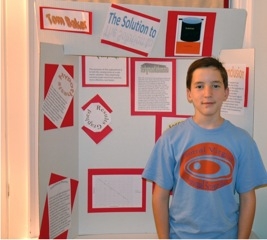 Dunbar Middle School for Innovation student, Tom Baker, is among the semi-finalists in the 2011 Broadcom MASTERS national science competition. Last year, when Tom was in sixth grade, his experiment, “The Solutions to Solutions,” took second place in the Chemistry Division of the regional science fair. That ranking put him in the running for this national competition.
Dunbar Middle School for Innovation student, Tom Baker, is among the semi-finalists in the 2011 Broadcom MASTERS national science competition. Last year, when Tom was in sixth grade, his experiment, “The Solutions to Solutions,” took second place in the Chemistry Division of the regional science fair. That ranking put him in the running for this national competition.
More than six-thousand students entered experiments into the Broadcom MASTERS. Tom is among only 300 students chosen as a semi-finalist. In a letter of congratulations to Tom, the President of the Society for Science and the Public said “you have already proven your ability to succeed in these subjects, which will lead you to an exciting career in anything you wish to be.”
On August 31 the finalists in the national competition will be announced. Those finalists will present their experiments during a competition in Washington, DC.
Below is a brief synopsis of his experiment:
In my science project, The Solution to Solutions, I measured the resistance of solutions of varying temperatures. I suspended nails on either side of a jar over a solution of 300ml of water and 3/4t salt. I measured the resistance between the nails with a multitester varying the temperatures of the saline solution. In the end, my hypothesis, that colder temperatures would have less resistance, was not supported. The warmer temperatures had less resistance. I believe the most logical explanation for this is that more hydrogen bonds were formed when the temperature was warmer, so the electrical current moved faster and encountered less resistance.
I got the idea for this experiment from my dad talking to one of his colleagues over the phone. He mentioned that some machine wasn’t conductive enough, so they could increase the conductivity, or try some odd, long named procedure on his patient. I originally intended to use a copper wire and a heat lamp, but I then considered that there might not be as much resistance along the copper wire as there would be with a solution.

